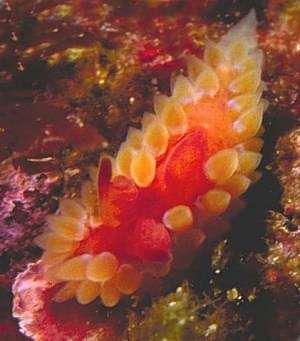
Caldukia rubignosa
Miller, 1970
Order: NUDIBRANCHIA
Suborder: ARMININA
Family: Zephyrinidae
DISTRIBUTION
Known from northeastern New Zealand.
PHOTO
Poor Knights Island, Northeastern New Zealand. PHOTO: Ian Skipworth. See Skip's Underwater Image Gallery.
Grows to about 12mm. Has been found from the intertidal, where it is found on the underside of stones, to about 13m depth. It feeds on bryozoans with records of it eating Beania magellanica and Dictyocladium moniliferum. Note the distinctive rhinophores, with the large swollen posterior club, which seem characteristic of the genus. Species of Caldukia seem to be confined to New Zealand and southeastern Australia.
References:
• Miller, M.C. (1970) Two new species of Caldukia Burn & Miller, 1969 from New Zealand waters. The Veliger, 12: 275-289.
• Miller, M.C. & Willan, R.C. (1986) A review of the New Zealand arminacean nudibranchs (Opisthobranchia: Arminacea). New Zealand Journal of Zoology, 13: 377-408.
Rudman, W.B., 1999 (May 8) Caldukia rubignosa Miller, 1970. [In] Sea Slug Forum. Australian Museum, Sydney. Available from http://www.seaslugforum.net/find/caldrubi
Related messages
Caldukia rubignosa from New Zealand
January 25, 2005
From: Ian Skipworth

Hi Bill
I think this is Caldukia rubignosa. I sent you a photo of another one a few years ago but this is a better photo. I've seen three of these on the last few dives at the Knights. One of them was much more lightly coloured but still the same slug I think.
Locality: Poor Knights Islands, NE New Zealand. Depth: 10m
Length: 12 mm.15 January 2005. rocky reef
Photographer: Ian Skipworth
Cheers
Ian
ian@ianskipworth.com
Skipworth, I., 2005 (Jan 25) Caldukia rubignosa from New Zealand. [Message in] Sea Slug Forum. Australian Museum, Sydney. Available from http://www.seaslugforum.net/find/12961
Thanks Ian,
Always good to get a bit of colour variation. I have included a close-up from your photo alongside to show the large bulbous swelling on the back of each rhinophore, which seems characteristic of Caldukia. The photo also shows the single branch of the digestive gland which runs up the centre of each ceras.
Best wishes,
Bill Rudman
Thanks for Caldukia id
May 9, 1999
From: Ian Skipworth
Thanks very much for that Bill.
Regards,
Ian
Auckland,
New Zealand.
ianskip@voyager.co.nz
Skipworth, I., 1999 (May 9) Thanks for Caldukia id. [Message in] Sea Slug Forum. Australian Museum, Sydney. Available from http://www.seaslugforum.net/find/853Caldukia rubignosa from New Zealand
May 8, 1999
From: Ian Skipworth

Dear Bill
Here is an image of a nudibranch or slug of some type. This was taken by me at the Poor Knights Islands [northeastern New Zealand] about a year and a half ago. For a while I forgot about the picture but reviewed it recently and started to wonder what it might be.
The slug is rather small and I have had to crop the 35mm frame fairly severely. This is despite the fact that it was taken with a 60mm micro Nikkor which does focus to 1:1. So, I am not quite sure just how small it is but guess it is probably less than 10mm long.
Any assistance you can provide would be much appreciated.
Regards,
Ian
ianskip@voyager.co.nz
Skipworth, I., 1999 (May 8) Caldukia rubignosa from New Zealand. [Message in] Sea Slug Forum. Australian Museum, Sydney. Available from http://www.seaslugforum.net/find/851Dear Ian,
This is Caldukia rubignosa a bryozoan-feeding nudibranch closely related to Janolus mokohinau. It is known only from northeastern New Zealand but there is a similar species Caldukia affinis which is found quite commonly in southeastern Australia.
As you judged from your photo, they seldom grow much larger than a centimeter.
Best wishes,
Bill Rudman.
